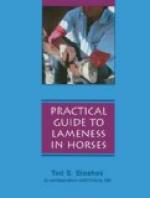Symptomatology.—The superficial flexor tendon (perforatus) alone, is the one usually contracted, and while both flexors are at times involved, this rarely occurs. The condition is usually bilateral.
The degree of contraction varies greatly in different cases. In some, contraction exists to such extent that it is impossible for the colt to stand, and because of continual decubitus where no relief is given, the subject is lost because of gangrenous infection occasioned by bed sores. Otherwise the same symptoms are to be observed in this condition, that exist in contraction of tendons of the mature animal.
Treatment.—Wherever contraction is not too marked and weight is borne with the affected members, and where the feet can be kept on the ground in a nearly normal position, it is possible to correct the condition without doing tenotomy. That is, in cases where the subject is simply “cock-ankled”, where volar flexion of the pastern joint exists but the foot is kept flat on the ground, correction is possible without tenotomy.
In such instances the foal must be treated early—before the skin on the anterior pastern region has been badly damaged by knuckling over. It is possible in many cases to stretch the flexor tendons by grasping the colt’s foot with one hand, and with the other hand one may push the pastern in the direction of dorsal flexion. This may be tried and when a reasonable amount of force is employed, no harm is done, even though no material benefit results. Some veterinarians claim good results from this treatment alone and direct their clients to repeat the stretching process several times daily.
Whether the tendons are manually stretched or not, splints should be adjusted to the affected members. The legs are padded with cotton and bandages and a suitable splint is applied on either side of the members and securely fixed in position by bandaging.
The splints are kept in position for four or five days and then removed for inspection of the affected parts. If necessary, they are reapplied and left in position for a week; however, this is unnecessary in the average case that is treated in this manner.
Where contraction exists to the extent that the subject can not stand and where no weight is borne by the feet, it is necessary to divide the affected tendons surgically. The same technic is put into practice that is employed in the mature subject but there is much greater chance for a favorable outcome in the foal. Further, if necessary, one may divide with impunity, both tendons on each leg, at the same time. In all cases this operation is done by observing strict aseptic precautions and the legs are, of course, bandaged. If both tendons are divided, splints should be employed and kept in position for ten days or two weeks. Primary union of the small surgical wound of the skin and fascia occurs in forty-eight hours.
The reader is referred to William’s “Veterinary Surgical and Obstetrical Operations,” for a complete description of this operation.




